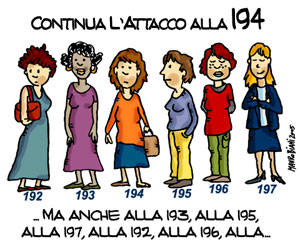Abortion: Italian Women Speak for Themselves
Rome – I am late writing this because, returning from an appointment, I couldn’t reach my home because of a demonstration—a special one. This time, and for the first time ever, women have blocked Piazza Venezia through Largo Argentina and on to the bridges to Trastevere. Their protest is over abortion—not to stop one, but to protect Law No. 194 which permits it. Similar demonstrations are still taking place this evening in Naples and Milan. Here’s why.
Last week a 39-year-old Neapolitan woman who had long desired a child discovered that the baby she was expecting suffered from a disease that would have left the child with severe problems, physical and mental. “I had so wanted the baby, but after the tests I decided I had little choice but to abort.” On Tuesday she went to a hospital for the operation, only to wake up afterward from the anesthesia to find herself surrounded by police, seven in all. As she, and all of Italy, would learn, a local magistrate, claiming he had been alerted by an anonymous telephone call, sent the police to the hospital to investigate because, according to the caller, the abortion was against the law because two weeks over the maximum permissible time, 22 weeks. (She claims she was 21 weeks pregnant.)
Yesterday the woman’s face and private story were all over the papers. The magistrate defended himself saying that he had “no choice” but to initiate an investigation once he received the phone call. It is true that Italian law has an automatic quality following any formal complaint to police, but in this case the conscientious magistrate ignored, if nothing else, judicial secrecy. By law any investigation is covered by official secrecy for a certain period, but this proviso was conveniently overlooked.
In these first days of a bitter contest for votes in the national elections scheduled for April 14, the Catholic vote matters, and some politicians are jockeying for position to claim it. At the moment the most prominent spokesman calling for the overturn of the law permitting abortion is chatty fattie Giuliano Ferrara, a born-again anti-abortionist whose latest proposal is to run a whole election ticket of people who agree with him. Silvio Berlusconi seemed to agree for a time, but is giving signs now of backing off.
Despite today’s demonstrations, in some ways times have not changed: men like Ferrara and Berlusconi are still the ones most eager to talk against abortion, and at a recent population conference a sincere-looking man, a tray of plastic foetuses strapped round his neck, stalked delegates. In Rome late last month directors of four university hospital obstetrics departments pleaded for ignoring parental views in view of late-term foetal survival, even at risk of handicap. As for induced abortion, overturning its legalization in Italy under Law No. 194 is already election rhetoric.
The women concerned say surprisingly little, until asked, which is exactly what I did during the referendum debate that paved the way for Italy’s legalization in 1978 of that law which some would now overturn. At that time I interviewed a number of married women living in converted horse barns in Catania. Their two-room homes usually had a surprisingly tidy room with a stove in one corner, a big bed in another, and, behind a curtain, a tiny bedroom shared by all the youngsters. The Sicilian social worker accompanying me whispered that ten children were the rule, and this proved true, though I had not believed her. Abortion was common: “Every family has an old aunt who knows what to do, using parsley infusions or a coat hook.” Incest, she also whispered, was a cause. I spoke with one Sicilian woman with six children who had had eight abortions, all illegal.
In Rome, I then spent an anguishing day in a not-very-clandestine abortion clinic, where I interviewed women before their abortions. The women’s voices were steeped in sorrow:
“I have been diagnosed with breast cancer and am still nursing my first baby. I can’t handle another baby now.”
“My husband and I have one child, but we are political refugees living on charity. We don’t know our future.”
“We’re from Calabria, with three children. My mother-in-law came with me.”
“I do housework, he works nights in a pub to support his mother, a widow. He has to graduate before raising a family.”
And on, and on, and on. Not one woman with whom I spoke—and most were women, not young girls—confronted abortion with anything but sadness. Abortion was about pain: physical and spiritual.
Nevertheless, it was clear that, legal or not, the women intended to have their abortion, no matter what the Church said, nor how illegal, nor how dangerous; the back-room abortions by the notorious “mammone” practitioners were often botched jobs which killed some women and left others sterile.
Since legalization, the number of induced abortions has fallen almost by half, from 228,737 in 1983 to 123,792 in 2002. At the same time, however, the number of live births has more or less stabilized; according to the August 2005 Journal of Modern Italian Studies, Italy had 562,600 lives births in 2004, comparable to the 575,000 in 1991. Every induced abortion therefore is matched by five live births, an improvement over the estimated one out of four of the 1970’s, but still a high ratio.
Why should this be so? According to the New York priest who heads an international “pro life” organization, money-hungry pill manufacturers push women into taking the pill, which leads to promiscuity, which leads to abortion; ipso facto, the pill produces abortions. If true anywhere, it is certainly not true in Italy, however. A causal effect of pill/abortion does exist, but is exactly the opposite: the lack of birth control method has perpetuated the continuing incidence of induced abortions.
A 2005 study published by the University of Padua shows that, following the birth of a second, third or fourth child, from 70-80% of Italian couples used coitus interruptus “with induced abortion as backup for contraceptive failures.”1
“In the male chauvinist culture of Southern Italy, a man’s ‘respectability’ is partly determined by his capacity for self-control in ensuring that his family can limit its number of children.” Where self-control failed, abortion was the rule, “especially among the poorer classes.” As a result, during the decade before abortion was legalized, 150,000-200,000 abortions were induced, or “about one abortion for every four births.”2
Those back in the 1970s who urged legalizing abortion in Italy did so in an effort not to be murderers, but to protect women. They also maintained that the way to avoid abortion was through education—a depressing number of girls had little understanding of their bodies—and birth control availability.
First, contraceptive methods are still relatively unusual in Italy even as condoms are sold next to candy bars in tobacco shops and supermarkets. Although a survey of 350 couples in Milan showed that around 70% in that Northern city used the pill, condom, or IUD, elsewhere coitus interruptus remains the norm. According to gynecologist Emilio Arisi, interviewed by La Repubblica Feb. 7, only 18% of women of fertile age use the pill and other hormonal contraceptives as compared with 40% in Germany. “Long-term contraceptive skin implants are not even sold in Italy [since] no one uses them.”
Secondly, whereas the women I had interviewed in 1975 were mature, today 57% of Italian girls have sex, usually unprotected, before age 16. Together with the limited use of contraceptives, this early venture into sex means that induced abortions continue as the birth control “fallback”—a political football that is also a threat to the poor, the ignorant and the very young.
1 G. Dalal Zuanna, A. De Rose, F. Racioppi, Journal of Population Research, Vol 22, No. 1, 2005, p. 23.
2 Op. cit.






































i-Italy
Facebook
Google+
This work may not be reproduced, in whole or in part, without prior written permission.
Questo lavoro non può essere riprodotto, in tutto o in parte, senza permesso scritto.